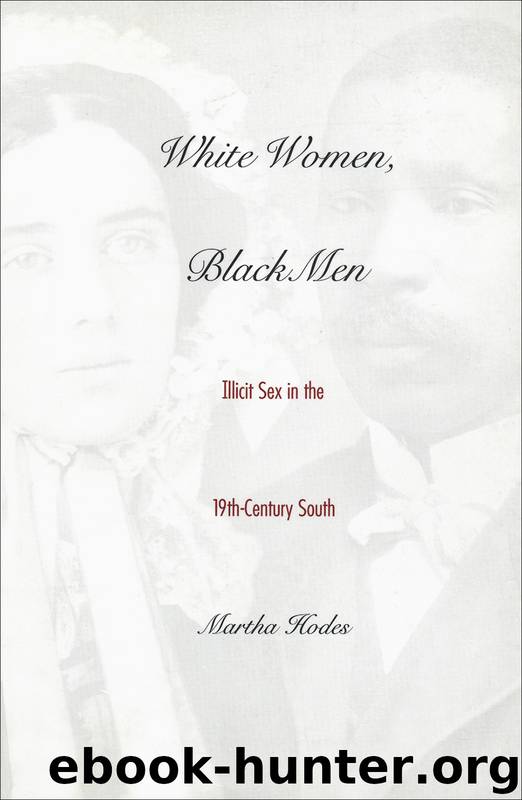White Women, Black Men by Martha Hodes

Author:Martha Hodes
Language: eng
Format: epub
Publisher: Yale University Press
Published: 1997-12-28T05:00:00+00:00
Klan victims had no effective legal recourse until as late as 1871. Anti-Klan laws passed by state governments proved nearly impossible to enforce, though the use of military power was slightly more effective. On the national level, President Ulysses S. Grant’s determination to control the Klan from 1868 (the year in which the violence reached its pinnacle) did not succeed in arrests and convictions until 1871. By the national election of 1872, the state governments of Virginia, Tennessee, North Carolina, and Georgia (and, briefly, Alabama) had been returned to Democratic rule or, in the language of white Southerners who despised both black and white Republicans, had been “redeemed.” Now white Southerners in the remaining Republican-controlled states began to change their tactics, moving away from undercover attacks on individuals and toward violence openly sanctioned by the Democratic party with the specific aim of winning elections. Although a great many undeterred freedmen continued to vote Republican, the Democratic party brought good numbers of new white voters to the polls. The Klan had been broken as an undercover organization, but the violence perpetrated from the end of the Civil War until 1871 had played at least some part in the ultimate demise of Reconstruction. With or without the Ku Klux Klan, such violence escalated as the end of the century approached.68
Throughout the South, the end of racial slavery spelled the end of a secure racial hierarchy for white people. At least some idealistic black people believed that the demise of slavery would mean the demise of racial distinctions, or as a black teacher wrote in his diary in 1868: “I heard a white man say, today is the black man’s day. Tomorrow will be the white man’s. I thought, poor man–Those days of distinction between colors is about over in this (now) free country.”69 In 1872, when a black minister was asked how many white men were members of a Florida organization in support of freedpeople, he declined to answer, saying, “We do not count noses, black or white; we take men.” The white interviewer persisted: “I am asking you a fact; men are white or colored, one of the two, although some of them are pretty well mixed,” and reiterated, “How many men of the white race are members of this organization?” With a measure of defiance, the minister replied, “I cannot tell.” But white people needed to tell and could not have disagreed more with the idea that black and white were “all one color now.”70
After the war, in order to preserve racial hierarchy, whites set out to fashion a more rigid dividing line based upon stricter racial categories. One of the most certain ways to sustain the racial categories of “black” and “white” was to make sure that people of African ancestry and people of European ancestry did not have children together. Of course, white men had been largely responsible for the mixture of European and African ancestry throughout the era of slavery, and their power of sexual coercion had stemmed precisely from their political, economic, and social authority in Southern society.
Download
This site does not store any files on its server. We only index and link to content provided by other sites. Please contact the content providers to delete copyright contents if any and email us, we'll remove relevant links or contents immediately.
| Anthropology | Archaeology |
| Philosophy | Politics & Government |
| Social Sciences | Sociology |
| Women's Studies |
Cecilia; Or, Memoirs of an Heiress — Volume 1 by Fanny Burney(31322)
Cecilia; Or, Memoirs of an Heiress — Volume 3 by Fanny Burney(30928)
Cecilia; Or, Memoirs of an Heiress — Volume 2 by Fanny Burney(30885)
The Great Music City by Andrea Baker(21166)
We're Going to Need More Wine by Gabrielle Union(18064)
Bombshells: Glamour Girls of a Lifetime by Sullivan Steve(13100)
Pimp by Iceberg Slim(12922)
All the Missing Girls by Megan Miranda(12739)
Fifty Shades Freed by E L James(12443)
Norse Mythology by Gaiman Neil(11873)
Talking to Strangers by Malcolm Gladwell(11859)
Crazy Rich Asians by Kevin Kwan(8340)
Mindhunter: Inside the FBI's Elite Serial Crime Unit by John E. Douglas & Mark Olshaker(7827)
The Lost Art of Listening by Michael P. Nichols(6461)
Enlightenment Now: The Case for Reason, Science, Humanism, and Progress by Steven Pinker(6402)
Bad Blood by John Carreyrou(5760)
The Four Agreements by Don Miguel Ruiz(5502)
Weapons of Math Destruction by Cathy O'Neil(5029)
We Need to Talk by Celeste Headlee(4861)
